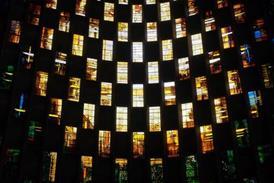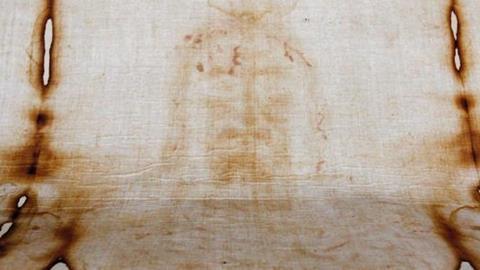Is the Shroud of Turin a medieval fake or the actual burial cloth of Jesus Christ? Long dismissed as a pious fraud, this mysterious linen cloth has drawn renewed interest from scientists and sceptics alike. A growing body of evidence now challenges the 1988 carbon dating and suggests the Shroud may be far more than just a curious relic.
Held in the Cathedral of Saint John the Baptist in Turin, Italy, the Shroud of Turin is a 14.4 ft x 3.6 ft linen cloth bearing the faint image of a crucified man. First photographed in 1898, the image stunned the world by appearing as a photographic negative, revealing lifelike details not visible to the naked eye. Scientific analyses have since uncovered characteristics that no known artistic method can replicate.
Experts have confirmed the presence of real human blood on the Shroud, consistent with crucifixion wounds, and pollen unique to the Jerusalem region has been identified on its surface. Despite carbon dating from 1988 suggesting a medieval origin, subsequent research revealed that the sample tested likely came from a repaired section unrepresentative of the original cloth.
Claims that the image was painted were largely based on flawed methodology and have been discredited by later peer-reviewed studies, particularly those conducted by the STURP team (Shroud of Turin Research Project, a multidisciplinary team of about 35 scientists who examined the Shroud directly) in 1978.
From Scepticism to Belief
Like many Christians, I once dismissed the Shroud without a second thought. But as I reviewed the research, I came to believe that it may indeed be the authentic burial cloth of Jesus Christ for the following reasons.
A Miraculous Image
The image on the Shroud affects only the top 1–2 microns of the linen fibres. No paint, pigment, or dye penetrates the cloth. When analysed using a VP-8 image analyser, the image revealed three-dimensional data—a feature no painting or photograph can replicate. No scientist has succeeded in reproducing the image using known materials or techniques.
Real Blood on the Cloth
Chemical tests by Dr. John Heller and Dr. Alan Adler confirmed that the red stains are real human blood. They identified:
- Heme and bilirubin (trauma-related blood components)
- Porphyrins (consistent with haemoglobin)
- Serum rings (visible under UV light, not paint)
These align with known crucifixion wounds. The blood soaked into the fibres before the image appeared, undermining any painting hypothesis.
Pollen Traces from the Holy Land
Swiss criminologist Max Frei identified over 50 pollen types on the Shroud, 28 of which come from plants native to the Jerusalem region. Notably:
- Gundelia tournefortii (linked to the crown of thorns)
- Zygophyllum dumosum (exclusive to the Judean Desert)
These findings suggest the Shroud travelled from the Holy Land, through Turkey, to France.
Why the Scepticism?
1. Carbon Dating (1988)
Three labs dated a corner of the Shroud to 1260–1390 AD. However, chemist Raymond Rogers later proved the tested area was from a medieval repair. His 2005 peer-reviewed study in Thermochimica Acta demonstrated that the corner was chemically and structurally different from the rest of the cloth. Many now consider the 1988 dating invalid.
2. The Paint Theory
Microscopist Walter McCrone claimed the image was made with pigments. But:
- He only analysed particles from tape-lift samples
- He did not use confirmatory spectroscopy
- He found no binding medium (e.g. oil or egg), which is essential for paint
The 1978 STURP team found no evidence of paint, dye, or brush strokes. Their work has stood up to scrutiny; McCrone’s has not. “There is no paint, dye, or stain on the fibrils that could account for the image.” – STURP Final Report
My Personal Conclusion
I now believe the Shroud may indeed be the authentic burial cloth of Jesus Christ, its image imprinted at the moment of resurrection. The evidence, both scientific and circumstantial, demands further investigation. Yet I’m frustrated. The Shroud is rarely accessible for study, fuelling speculation instead of clarity. In 2025, we have the tools to investigate this artefact like never before—why aren’t we using them?
A Three-Part Appeal in Closing
To Pope Leo XIV: Please allow further scientific analysis of the Shroud. The world deserves to know more.
To Sceptics: Have you questioned your assumptions about McCrone and the carbon dating? Can you look at the Shroud and allow for the possibility that it’s real?
To Protestant Christians: We often overlook the Shroud, but it has brought many to faith. Let’s become informed and open-minded about this remarkable object.
The Shroud of Turin could be the most astonishing forgery in history—or the most tangible evidence we have of the resurrection of Jesus Christ. Either way, it deserves our attention. And perhaps most of all, our wonder.
Drew Cordell is a business consultant who has worked alongside some of the world’s most successful businesses and their leaders in an extensive corporate career in both London and Australia. His new book Honest Christianity: Why People Choose to Believe is available on Amazon and all good bookstores.


















